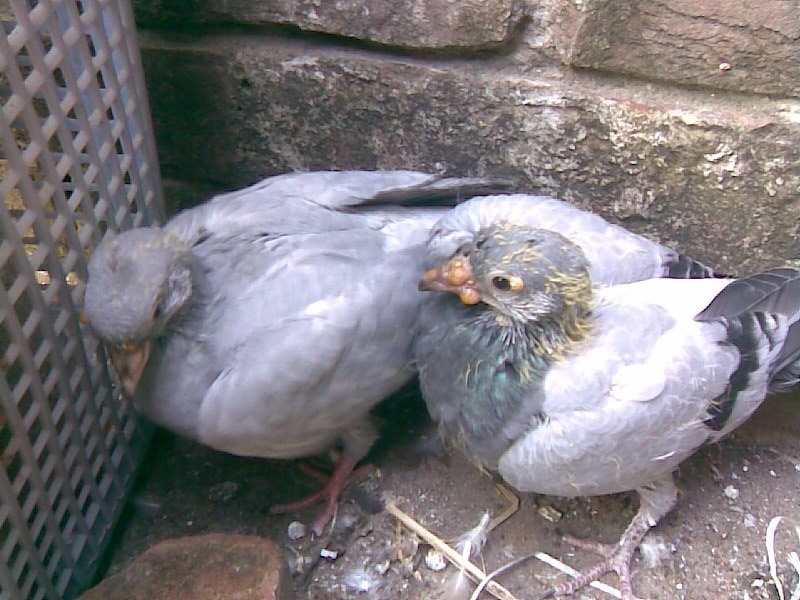Pigeonpox on:
[Wikipedia]
[Google]
[Amazon]
 Pigeon pox is a viral disease to which only
Pigeon pox is a viral disease to which only
 Pigeon pox is a viral disease to which only
Pigeon pox is a viral disease to which only pigeons
Columbidae () is a bird family consisting of doves and pigeons. It is the only family in the order Columbiformes. These are stout-bodied birds with short necks and short slender bills that in some species feature fleshy ceres. They primarily ...
are susceptible. It is characterized by pox scabs, which most frequently form on the featherless parts of the bird. The disease is caused by the Pigeon pox virus. It can be transmitted by droplet infection from one animal to another, or more commonly through infected insects or the digestion of contaminated food or water.
There is a live viral vaccine
A vaccine is a biological Dosage form, preparation that provides active acquired immunity to a particular infectious disease, infectious or cancer, malignant disease. The safety and effectiveness of vaccines has been widely studied and verifie ...
available for ''Pigeon pox virus'' (ATCvet
The Anatomical Therapeutic Chemical (ATC) Classification System is a drug classification system that classifies the active ingredients of drugs according to the organ or system on which they act and their therapeutic, pharmacological and chemical p ...
code: ).
Signs and symptoms
An animal infected with the pigeon pox virus may experience symptoms such as dehydration,uveitis
Uveitis () is inflammation of the uvea, the pigmented layer of the eye between the inner retina and the outer fibrous layer composed of the sclera and cornea. The uvea consists of the middle layer of pigmented vascular structures of the eye and ...
and vision problems, reduction in egg production and behavioural differences. Such animals are described as quiet and fluffed. Some of the infected animals show yellow and roundish nodules with a diameter of 0,5 – 1,0 cm under the eyelids, the beak and mouth. Lesions under the wing, the nasal area and the mouth commissure usually appear after a period of 10 – 12 days. These symptoms are usually divided into two main forms. The skin and mucous progression. Some experts even suggest a division into up to 5 different categories.
The animal will generally recover from the infection within 6 weeks and the virus is only on very rare occasions lethal.
Diagnosis
Most pigeons are diagnosed with pigeon pox due to obvious clinical signs, such as lesions on the featherless parts of their body. With that also comes the difficulty of breathing as well as tiredness and sometimes problems in swallowing. To further validate the diagnosis a histological examination of a biopsy or the evaluation of vesicles liquid under an electronic microscope is used. However, a definite diagnosis can only be provided by the proof of the Pigeon Pox virus.Treatment and prevention
A treatment is not possible or known and scientifically proven, but vitamin A and antibacterial substances have shown, that they can help in the prevention of the occurrence of secondary infections. It is recommended to remove bloodyulcers
An ulcer is a discontinuity or break in a bodily membrane that impedes normal function of the affected organ. According to Robbins's pathology, "ulcer is the breach of the continuity of skin, epithelium or mucous membrane caused by sloughing o ...
if they are present. The nodules should not be treated surgically or manually to prevent possible infections during the healing period.
Therefore a vaccination with an attenuated vaccine
An attenuated vaccine (or a live attenuated vaccine, LAV) is a vaccine created by reducing the virulence of a pathogen, but still keeping it viable (or "live"). Attenuation takes an infectious agent and alters it so that it becomes harmless or less ...
such as a prophylaxis
Preventive healthcare, or prophylaxis, consists of measures taken for the purposes of disease prevention.Hugh R. Leavell and E. Gurney Clark as "the science and art of preventing disease, prolonging life, and promoting physical and mental hea ...
is used. Using the wing-web-method the vaccine is injected intramuscularly. This form of preventive healthcare is mostly used in healthy animals when a breakout of the illness occurs in other animals in the surrounding area.
Epidemiology
The virus has a worldwide frequent incidence in all free-living pigeon species, -breeds and urban pigeons.References
Bird diseases Chordopoxvirinae {{Veterinary-med-stub